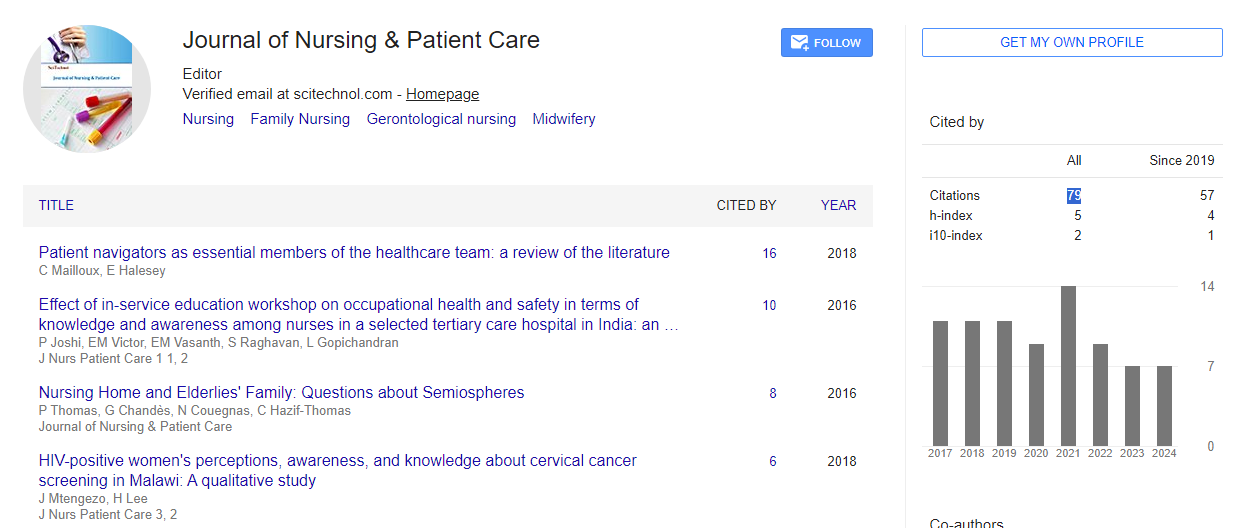Perspective, J Nurs Patient Care Vol: 9 Issue: 4
Importance of Early Detection and Nursing Care in Minimizing Injuries Related to Aging
James Fran*
1Department of Nursing, University of Balearic Islands, Illes Balears, Spain
*Corresponding Author: James Fran,
Department of Nursing, University of
Balearic Islands, Illes Balears, Spain
E-mail: franja@mes.es
Received date: 23 November, 2024, Manuscript No. JNPC-24-155460;
Editor assigned date: 25 November, 2024, PreQC No. JNPC-24-155460 (PQ);
Reviewed date: 09 December, 2024, QC No. JNPC-24-155460;
Revised date: 17 December, 2024, Manuscript No. JNPC-24-155460 (R);
Published date: 24 December, 2024, DOI: 10.4172/2573-4571.1000081.
Citation: Fran J (2024) Importance of Early Detection and Nursing Care in Minimizing Injuries Related to Aging. J Nurs Patient Care 9:4.
Description
As individuals age, they become more susceptible to a range of physical injuries due to changes in muscle mass, bone density, balance and coordination. Injuries in older adults, such as falls, fractures and pressure ulcers, can have a significant impact on their overall health and happiness, often leading to a decline in independence and quality of life. Early detection and proactive nursing care are essential in reducing the risk of these injuries and ensuring that older adults receive the support they need for effective recovery. One of the primary challenges for older adults is an increased risk of falls. According to the Centers for Disease Control and Prevention (CDC), one in four adults aged 65 and older falls each year, and falls are a leading cause of injury related death in this age group. Falls can result in fractures, head injuries and soft tissue damage, which may require extended hospital stays or rehabilitation. Early detection of fall risks is essential in preventing these injuries. Nurses play a key role in assessing the fall risk of older adults by conducting regular screenings. These screenings include evaluating factors such as gait, balance, vision, medication use and environmental hazards.
Beyond falls, older adults also face an increased risk of bone fractures, especially in individuals with osteoporosis, a condition where bones become hard and delicate. Hip fractures, in particular are a common and serious consequence of osteoporosis. Early detection through regular bone density screenings can help identify those at high risk for fractures, enabling nurses to provide appropriate interventions, such as educating patients on proper nutrition, weight-bearing exercises and medication to strengthen bones. Additionally, nurses can help ensure that patients understand the importance of avoiding activities that could result in injury, such as lifting heavy objects or engaging in high impact physical activities. In this way, early detection and nursing care can help minimize the impact of osteoporosis-related injuries.
Another significant issue for older adults is the development of pressure ulcers, also known as bedsores, which can occur when a person is immobile for prolonged periods. Pressure ulcers can be painful, difficult to treat and lead to serious complications like infections. Early detection is essential in preventing the development of these ulcers. Nurses are trained to regularly assess skin integrity, especially in patients who are bedridden or have limited mobility. By performing routine skin inspections and applying preventative measures, such as repositioning patients, using pressure-relieving devices and ensuring proper hydration and nutrition, nurses can help minimize the risk of pressure ulcers and promote skin health.
Nurses also play an essential role in managing the emotional and psychological impact of aging-related injuries. The experience of injury, particularly from falls or fractures, can lead to anxiety, depression and a loss of confidence in performing daily activities. Nurses can provide emotional support, reassurance and counseling to help older adults cope with the challenges of their injuries. Encouraging older adults to remain socially engaged, light physical activity as appropriate and stay involved in their care decisions can improve mental health and enhance recovery outcomes.
Conclusion
Early detection and nursing care are important in reducing injuries related to aging. Through regular screenings, fall risk assessments and proactive education, nurses can help prevent injuries such as falls, fractures and pressure ulcers in older adults. By identifying risks early, implementing preventive strategies and offering continuous support, nurses contribute to improving the overall health, safety and quality of life for older individuals. Early intervention not only reduces the occurrence of injuries but also promotes faster recovery and better long term outcomes for aging populations.
 Spanish
Spanish  Chinese
Chinese  Russian
Russian  German
German  French
French  Japanese
Japanese  Portuguese
Portuguese  Hindi
Hindi 